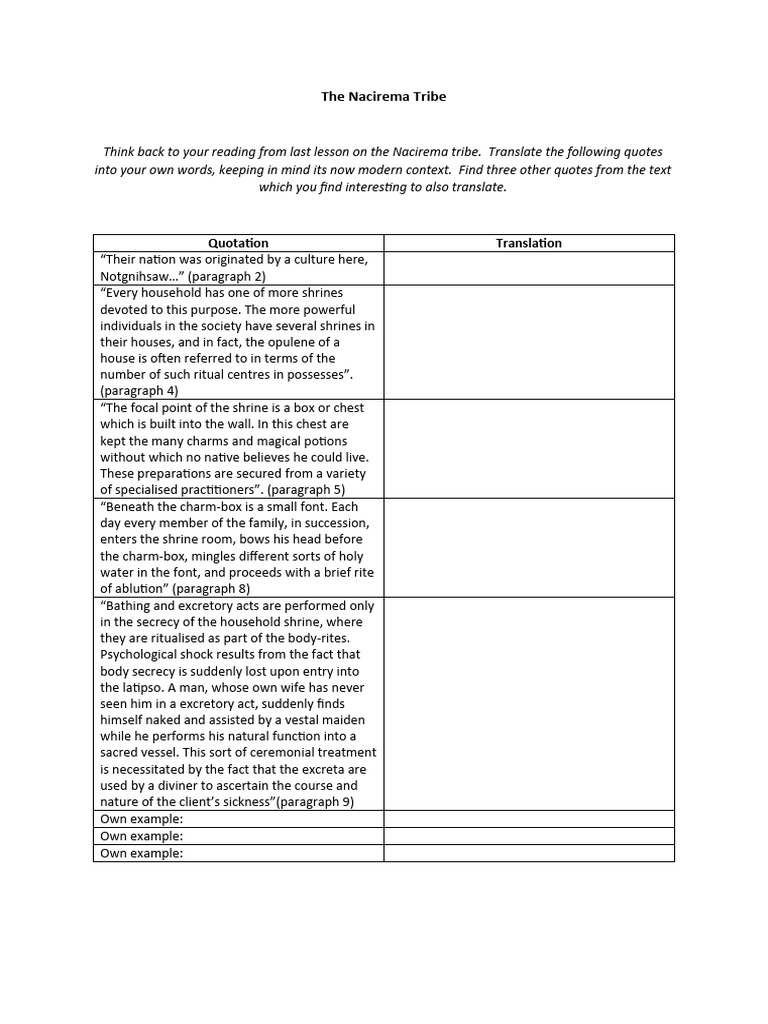The Nacirema tribe, often viewed through the lens of anthropological curiosity, presents a fascinating case study in the interplay between culture and art. This peculiar group, residing in the North American continent, has garnered attention for its unique rituals and customs, leading to an intriguing exploration of their artistic expressions. The Nacirema’s art is not merely a form of decoration; it embodies their beliefs, societal structures, and individual identities.
At the core of Nacirema art are the everyday artifacts imbued with deeper meanings, often serving as focal points for their more elaborate ceremonies. Pottery, masks, and body adornments serve as splendid evidences of the tribe’s intricate belief system. For instance, the creation of ceramic bowls is paramount among their artistic expressions. The intricacy of designs illustrates not only craftsmanship but a connection to the spiritual realm. The question then arises: do these artistic representations serve merely as social identifiers, or do they also act as vessels carrying the tribe’s history forward?
Nacirema art is also characterized by its distinctive use of colors and patterns. Each hue has significance, often corresponding to different elements of their cosmology. For example, red may symbolize life and vitality, while blue may denote tranquility and balance. The symbolism woven into their artwork challenges onlookers to consider how color fundamentally influences emotional resonance and societal connections. The rich tapestry of patterns, intricate and often labyrinthine, invites the eye to not only appreciate their beauty but also decipher hidden messages within. This leads to another inquiry: how do the experiences and collective memory of the Nacirema create a narrative that is both visually and emotionally compelling?
Furthermore, the Nacirema employ a range of materials for their artistic endeavors. Bone, clay, wood, and even organic materials such as feathers and leaves are meticulously transformed into art forms. The utilization of such varied materials showcases the tribe’s resourcefulness and symbiosis with their environment. This artistic practice evokes the question of sustainability: how can the Nacirema balance their artistic needs with the ecological realities of their natural surroundings? Could the evolving relationship between their artistry and the environment serve as a model for contemporary societies facing ecological crises?
Rituals play a pivotal role in the Nacirema’s artistic expressions, often providing context for the creation and display of art. Ritual masks, typically worn during significant ceremonies, embody not only aesthetic qualities but also spiritual significance. They are considered to be vessels for ancestral spirits, merging the physical and metaphysical realms. This invites contemplation on how performing art in religious or cultural rituals can deepen communal ties and personal identity. Are these artistic performances merely a reflection of belief, or do they actively shape the cultural identity of the Nacirema?
The act of body adornment among the Nacirema is another compelling aspect of their art. The tribe practices extensive rituals involving body painting, tattooing, and the use of jewelry. These adornments carry implications of status, age, and even lineage. The challenge presented here is the negotiation between individuality and conformity within these artistic practices. How do Nacirema individuals assert their personal identities within the confines of cultural expectations through their artistic expressions?
The dynamic nature of Nacirema art allows for continual evolution. As external influences permeate their society, their artistic expressions have shown adaptability while retaining core values. Contemporary Nacirema artists often blend traditional motifs with modern techniques, resulting in an innovative fusion of old and new. This observation prompts consideration of artistic integrity and cultural preservation: can the incorporation of new influences be seen as a dilution or as an enriching expansion of Nacirema heritage?
Moreover, the collective and often collaborative aspect of art in Nacirema society highlights the importance of community. Group efforts in creating large-scale murals or communal sculptures challenge the conventional notion of the solitary artist. Such collaborative creations can foster a sense of belonging and shared purpose. In a world increasingly marred by isolation, what lessons might be drawn from the communal artistic endeavors of the Nacirema for fostering societal cohesion in contemporary contexts?
As one delves into the artistic fabric of the Nacirema tribe, it becomes apparent that their art is more than mere aesthetic pleasure. It serves as a complex web of meanings encompassing cultural heritage, social identity, and spiritual beliefs. Each piece of art is a potent reminder of the interconnectedness of culture, tradition, and individual expression. However, this intertwining presents a challenge for future generations—how can they strive to maintain artistic traditions while embracing innovation and change without losing their cultural identity?
Ultimately, the art of the Nacirema tribe stands as a testament to human creativity and adaptability. It unveils the rich tapestry of their lived experiences, beliefs, and aspirations. The questions posed throughout this exploration are not just idle musings; they represent critical junctures in understanding cultural identity through art. As the Nacirema continue to navigate the balance between tradition and modernity, they inspire reflection on our own artistic expressions within an ever-evolving global landscape. How will the narratives and challenges faced by the Nacirema impact future generations of artists and cultural custodians?
